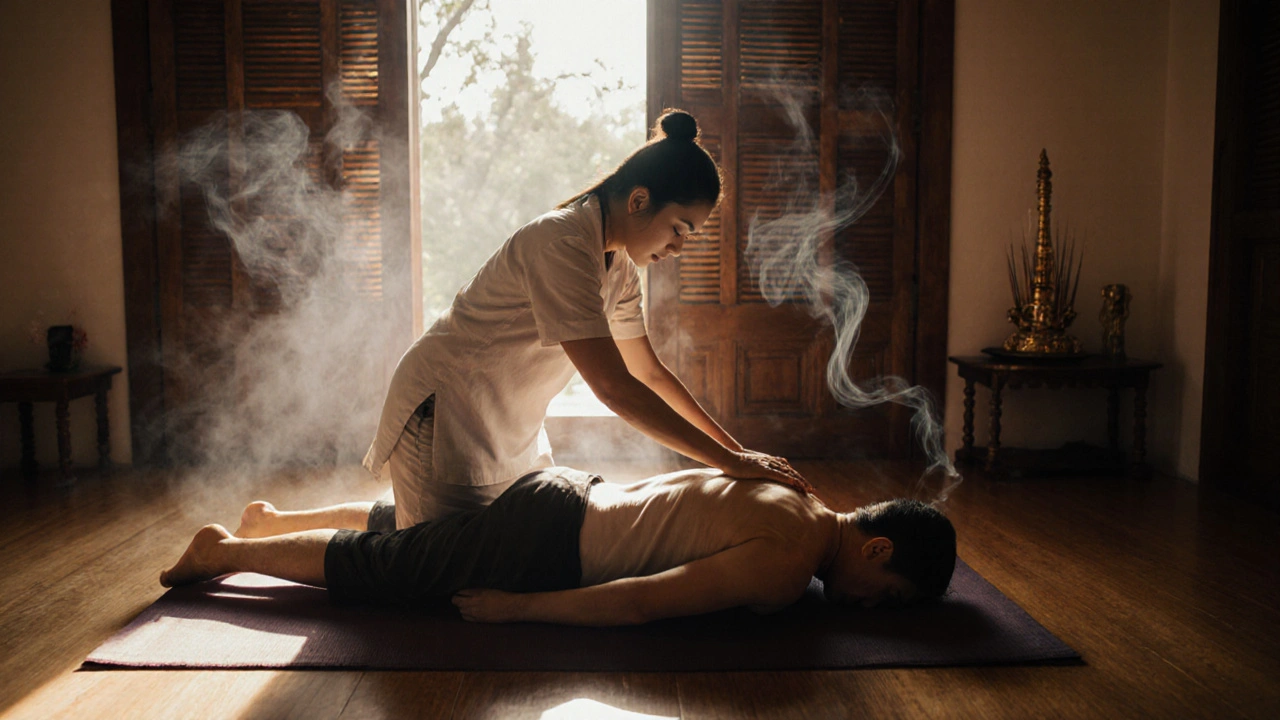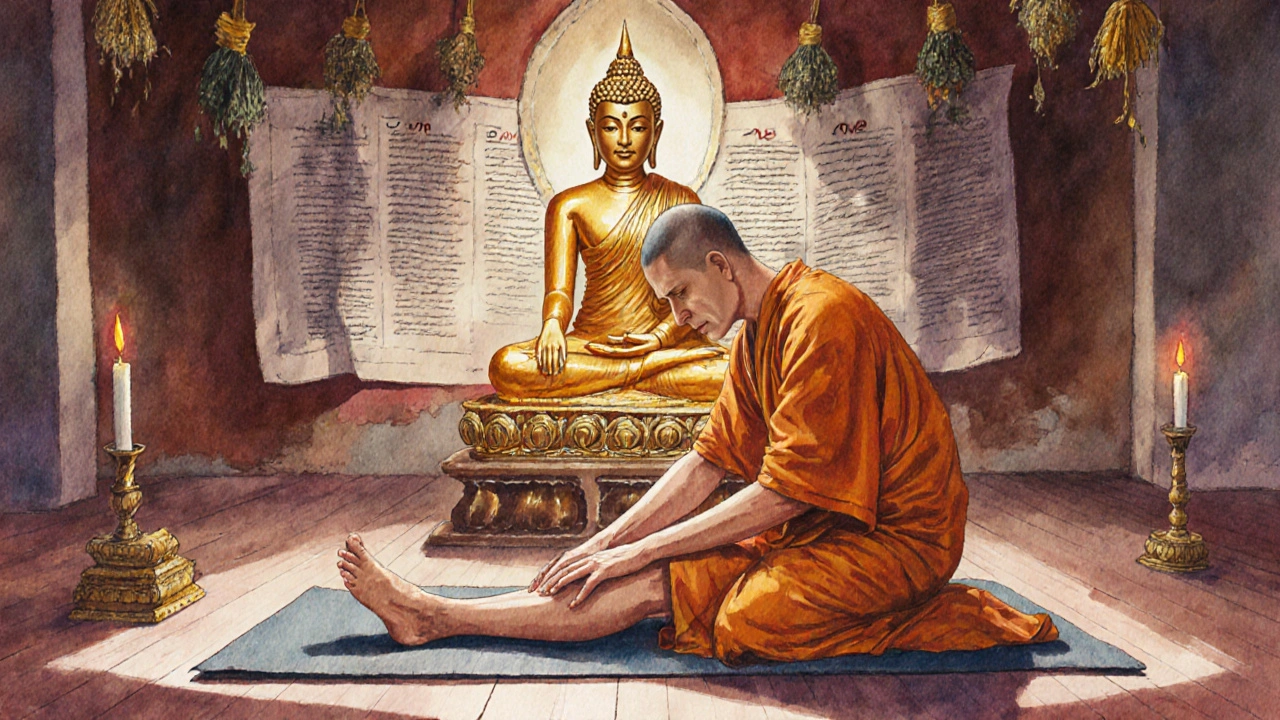Experience the Ancient Art of Thai Massage: A Living Tradition of Healing
 Nov, 15 2025
Nov, 15 2025
Thai Massage Suitability Checker
This tool helps you determine if Thai massage would be beneficial for your specific physical condition and lifestyle based on the article's guidance.
Let's find your ideal Thai massage match
Answer a few questions about your current physical condition to receive personalized recommendations.
Your Personalized Recommendation
Thai massage isn’t just another spa treatment. It’s a 2,500-year-old healing system that blends acupressure, assisted yoga postures, and energy line work - all done on a mat on the floor, fully clothed. You don’t just relax during a session. You’re actively moved, stretched, and pressed in ways that feel both intense and deeply soothing. If you’ve ever walked out of a Thai massage feeling like your body had been reset, you’re not imagining it. This isn’t magic. It’s science wrapped in tradition.
How Thai Massage Is Different From Other Massage Types
Swedish massage uses oils and gentle strokes to relax muscles. Deep tissue targets knots with firm pressure. Thai massage does neither. It works on the body’s energy lines, called sen lines, which are similar to meridians in Traditional Chinese Medicine. There are 10 main sen lines running through the body, and practitioners apply pressure along these paths using their thumbs, palms, elbows, knees, and even feet.
Unlike other massages where you lie still, Thai massage is dynamic. You’re guided through a series of passive stretches - like a yoga session where someone else moves your limbs. Your shoulders might be pulled gently backward, your legs rotated, your spine twisted slightly. It’s not about forcing flexibility. It’s about releasing tension built up over years of sitting, typing, or standing.
One study from Chiang Mai University tracked 60 participants over eight weeks and found that those who received weekly Thai massage sessions reported a 35% reduction in chronic lower back pain. That’s more than what’s typically seen with standard physical therapy. The reason? Thai massage doesn’t just treat the pain. It restores movement patterns that the body has forgotten.
The History Behind the Hands
Thai massage traces back to the time of the Buddha, around 500 BCE. It’s credited to Shivago Komarpaj, a physician and disciple of the Buddha, who combined Indian Ayurvedic practices with traditional Thai herbal medicine and Chinese energy principles. For centuries, it was taught in Buddhist temples across Thailand. Monks practiced it not just as therapy, but as an act of compassion.
Today, you’ll still find traditional Thai massage taught in temples like Wat Pho in Bangkok - the same temple that houses the giant golden reclining Buddha. Wat Pho’s massage school is the oldest in Thailand, and it’s where most modern Thai massage therapists trained. The techniques haven’t changed much. The same pressure points, the same sequences, the same intention: to bring balance to the body’s energy flow.
What’s surprising is how little it’s changed in the West. Many spas offer "Thai massage" but skip the stretching, use oils, or skip the floor work. That’s not authentic Thai massage. Real Thai massage is done on a mat. No oils. No music. Just quiet, focused movement. The therapist works with your breath, timing each stretch to your inhale or exhale.
What Happens During a Session
You wear loose, comfortable clothing - no undressing needed. The room is warm, quiet. The therapist begins at your feet, working slowly up your body. They start with gentle pressure on the soles, then move to the calves, thighs, hips, and spine. Each movement is deliberate. There’s no rushing.
You’ll feel pressure - sometimes deep, sometimes surprising. That’s normal. It’s not pain. It’s the sensation of tight tissues letting go. One moment, you’re being stretched into a seated forward fold. The next, your therapist is using their knee to gently press your lower back into extension. It’s not aggressive. It’s controlled. And it works.
Most sessions last 60 to 90 minutes. Afterward, you’ll feel lighter. Not just physically. Mentally, too. That’s because Thai massage activates the parasympathetic nervous system - the part of your body that says, “It’s safe to rest.” Your heart rate slows. Your breathing deepens. Your cortisol levels drop. You don’t just feel relaxed. You feel restored.

Who Benefits Most From Thai Massage
People with desk jobs. Athletes recovering from injury. Anyone who’s stiff from aging or stress. But it’s not just for the physically tense. Thai massage helps with anxiety, headaches, and even digestive issues because of how it stimulates the vagus nerve - the body’s main relaxation pathway.
One woman in Sydney, 58, started Thai massage after years of chronic shoulder pain from typing. She’d tried physiotherapy, acupuncture, even cortisone shots. Nothing stuck. After six weekly Thai massage sessions, she could raise her arm above her head without pain for the first time in five years. She didn’t get stronger. She got freer.
Seniors find it especially helpful. Unlike yoga, where you have to hold poses yourself, Thai massage does the work for you. You don’t need flexibility. You just need to breathe. And let go.
What to Look For in a Practitioner
Not all Thai massage therapists are trained the same way. Some learned from YouTube. Others trained in Bangkok for years. Ask where they trained. If they say “online course,” walk away. Authentic Thai massage requires hands-on apprenticeship.
Look for therapists who:
- Work on a mat, not a table
- Don’t use oils or lotions
- Use their body weight, not just hands
- Move you through sequences, not just press points
- Ask about your pain, mobility, or injuries before starting
Good therapists will never force you into a stretch. They’ll pause, check your breathing, and adjust. If they push too hard, speak up. Thai massage is about cooperation, not compliance.

What to Expect After Your First Session
Some people feel euphoric. Others feel sore - like they’ve had a deep workout. That’s normal. Your muscles have been stretched and compressed in ways they haven’t experienced in years. Drink water. Rest. Avoid intense exercise for 24 hours.
You might feel emotional. Thai massage can unlock stored tension - not just physical, but emotional. It’s common to cry during or after a session. That’s not weakness. It’s release. Your body held that stress for a reason. Now, it’s letting go.
Most people notice changes after three sessions. Your posture improves. You sleep better. You move without thinking about it. That’s the goal. Thai massage doesn’t just treat symptoms. It reteaches your body how to move naturally.
Why This Ancient Practice Still Works Today
In a world of apps, algorithms, and quick fixes, Thai massage is a quiet rebellion. It takes time. It requires presence. It doesn’t promise instant results. But it delivers something deeper: restoration.
Modern science is finally catching up. Studies show Thai massage increases circulation, reduces inflammation, improves joint mobility, and even boosts immune function. But the real power isn’t in the data. It’s in the experience. When someone uses their hands, knees, and body weight to help you breathe again - that’s not therapy. That’s connection.
You don’t need to travel to Thailand to feel it. You just need to find the right practitioner. And let yourself be moved.
Is Thai massage painful?
It can feel intense, but it shouldn’t hurt. Thai massage uses deep pressure, but it’s always controlled. If you feel sharp pain, tell your therapist. They’ll adjust. The goal is deep release, not discomfort. Most people describe it as "good pain" - the kind that makes you sigh.
Do I need to be flexible to try Thai massage?
No. Thai massage is designed for people who aren’t flexible. The therapist moves your body for you. You don’t have to stretch or hold poses. Even if you can’t touch your toes, you’ll still benefit. The stretches are gentle and adapted to your range of motion.
How often should I get Thai massage?
For general wellness, once a month works well. If you have chronic pain or stiffness, twice a month for 2-3 months helps reset your body. Athletes often get it weekly during training seasons. There’s no strict rule - listen to your body. If you feel better after a session, you’re likely ready for the next one.
Can Thai massage help with back pain?
Yes. Many people with chronic lower back pain find relief through Thai massage. It releases tension in the hips, hamstrings, and spine - areas that often cause back strain. A 2023 study in the Journal of Bodywork and Movement Therapies showed a 42% improvement in back mobility after six sessions. It doesn’t cure structural issues, but it restores movement that pain has stolen.
What should I wear to a Thai massage?
Wear loose, comfortable clothing that allows movement - like yoga pants and a T-shirt. No underwear changes or oils are needed. The therapist works through your clothes. Avoid tight jeans, skirts, or anything restrictive. Comfort is key.
Is Thai massage safe during pregnancy?
Yes, but only with a therapist trained in prenatal Thai massage. Standard techniques can be too intense for pregnant women. A skilled therapist will avoid deep pressure on the abdomen and certain pressure points. Always inform your therapist you’re pregnant before the session begins.
How is Thai massage different from yoga?
In yoga, you move your own body. In Thai massage, someone else moves you. It’s passive stretching with pressure. You don’t need to remember poses or breathe in a certain way. The therapist guides your breath and movement. It’s like yoga with a partner who knows exactly where to press and when to release.
Can I do Thai massage at home?
You can learn basic stretches, but true Thai massage requires training. The pressure points, energy lines, and sequencing are complex. Trying to mimic it on a friend can lead to injury. If you want to practice at home, learn self-massage techniques for your feet and neck. But for full benefits, see a trained therapist.
If you’ve ever felt stuck - in your body, in your mind, in your routine - Thai massage offers a way out. Not through pills or procedures. But through touch, breath, and time. It’s not a trend. It’s a tradition that still works. And it’s waiting for you.
